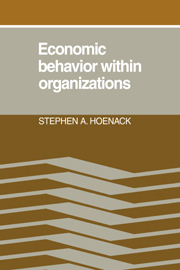Book contents
- Frontmatter
- Contents
- Preface
- 1 Introduction
- 2 Definitions and determinants of employees' discretion over an organization's resources and production
- 3 Employees' resource diversions and employers' imposition of resource responsibility
- 4 Short-run resource allocation under fixed budgets
- 5 Short-run resource allocation in response to demand: the cases of an employee, a private corporation, and a private nonprofit organization
- 6 Legislative demand and short-run price and output of the public organization
- 7 Employees' investment behavior and implications for suborganization
- 8 Equilibrium behavior of public and private organizations in the first long run
- 9 The demand and supply of nonmarket resource allocation
- 10 A brief summary and proposed directions for further work
- Notes
- References
- Core definitions
- Index
4 - Short-run resource allocation under fixed budgets
Published online by Cambridge University Press: 05 November 2011
- Frontmatter
- Contents
- Preface
- 1 Introduction
- 2 Definitions and determinants of employees' discretion over an organization's resources and production
- 3 Employees' resource diversions and employers' imposition of resource responsibility
- 4 Short-run resource allocation under fixed budgets
- 5 Short-run resource allocation in response to demand: the cases of an employee, a private corporation, and a private nonprofit organization
- 6 Legislative demand and short-run price and output of the public organization
- 7 Employees' investment behavior and implications for suborganization
- 8 Equilibrium behavior of public and private organizations in the first long run
- 9 The demand and supply of nonmarket resource allocation
- 10 A brief summary and proposed directions for further work
- Notes
- References
- Core definitions
- Index
Summary
This and the next two chapters analyze the resource allocation behavior of individual employees and of their organizations in the “short run.” The short run is a time period within which current investment behavior does not affect resource allocation. Two types of past investments determine the capital stock underlying the organization's short-run productive activity. The first and more obvious includes the organization's plant and equipment and its employees' skills. The second consists of those investments analyzed in Chapter 7 that determine the division of the organization's production functions into production domains, the information held by employees about production domains, the placing of resource responsibility on employees, and the means by which employees voluntarily coordinate themselves. In the short run all the results of both types of past investments are given and fixed.
This chapter first analyzes resource allocation under overall value and specific responsibility, making the simplifying assumption that there are no technological spillovers among employees' production domains. For each of these two types of responsibility a separate section explains how the equilibrium quantities of an employee's outputs are determined, derives the employee's and his employer's costs of these outputs, determines the employee's uses of each input and output, and derives the implicit prices that he attaches to these resources. The employee's and his employer's demands for information about production domains and preferences are also explained. Resource allocation under these two types of responsibility is contrasted with that occurring under CPOR.
- Type
- Chapter
- Information
- Economic Behaviour within Organizations , pp. 68 - 112Publisher: Cambridge University PressPrint publication year: 1983



